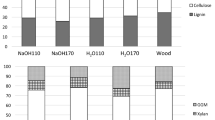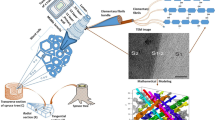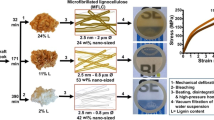Abstract
The hierarchic organization of cellulose fibrils (microfibrils) was investigated in holocellulose, sulphite pulp and kraft pulp using TEM, XRD, ED and FTIR. There were remarkable differences in both the fibril structure and fibril aggregation between the samples. TEM observations revealed more intimately associated fibrils in the kraft pulp compared to the sulphite pulp and the holocellulose, results in agreement with previous CP/MAS 13C-NMR data [Hult E.-L. et al. (2002) Holzforschung 56: 231–234]. Furthermore, the cellulose crystallinity was higher in the kraft pulp sample. With respect to the cellulose Iα and Iβ allomorphs, these samples were controversial when different analytical techniques were applied. Due to the small fibril size and the low degree of order of cellulose in these samples, the concept of crystalline triclinic and monoclinic components as determined by diffraction analysis may not be adequate. Instead the fibril can be regarded to have different degrees of lateral order (including paracrystalline ordering) that can be reoriented to Iβ type conformation and packing upon pulping.
Similar content being viewed by others
References
Abe H., Ohtani J. and Fukazawa K. 1991. FE-SEM observations on the microfibrillar orientation in the secondary wall of tracheids. IAWA Bulletin n.s. 12: 431-438.
Åkerholm M. and Salmen L. 2002. Dynamic FTIR spectroscopy for carbohydrate analysis of wood pulps. J. Pulp Pap. Sci. 28: 245-249.
Atalla R.H. and VanderHart D.L. 1984. Native cellulose: a composite of two distinct crystalline forms. Science 223: 283-285.
Atalla R.H. and Whitmore R.E. 1978. The influence of elevated temperatures on structure in the isolation of native cellulose. J. Poly. Sci. Polym. Lett. 16: 601-605.
Chanzy H., Imada K., Mollard A., Vuong R. and Barnoud F. 1979. Crystallographic aspects of sub-elementary cellulose fibrils occurring in the wall of rose cells cultured in vitro. Protoplasma 100: 303-306.
Duchesne I. and Daniel G. 2000. Changes in surface ultrastructure of Norway spruce fibres during kraft pulping-visualization by field emission-SEM. Nord. Pulp Pap. Res. J. 15: 54-61.
Duchesne I., Hult E.-L., Molin U., Daniel G., Iversen T. and Lennholm H. 2001. The influence of hemicellulose on fibril aggregation of kraft pulp fibres as revealed by FE-SEM and CP/MAS 13C-NMR. Cellulose 8: 103-111.
Evans R.E., Newman R.H., Roick U.C., Suckling I.D. and Wallis A.F.A. 1995. Changes in cellulose crystallinity during kraft pulping. An analysis by three methods. Holzforschung 49: 498-504.
Hafren J. 1999. Ultrastructure of the wood cell wall. Ph.D. Thesis. Royal Institute of Technology, Stockholm, Sweden.
Helbert W., Sugiyama J., Ishihara M. and Yamanaka S. 1997. Characterization of native crystalline cellulose in the cell walls of Oomycota. J. Biotechnol. 57: 29-37.
Hirai A., Tsuji M. and Horii F. 1997. Culture conditions producing structure entities composed of Cellulose I and II in bacterial cellulose. Cellulose 4: 239-245.
Horii T., Hirai A. and Kitamaru R. 1987. CP/MAS 13C NMR spectra of the crystalline components of native cellulose. Macromolecules 20: 2117-2120.
Hult E.-L., Larsson T. and Iversen T. 2000. A comparative CP/MAS 13C-NMR study of the cellulose structure in spruce wood and kraft pulp. Cellulose 7: 35-55.
Hult E.-L., Larsson T. and Iversen T. 2001. Cellulose fibril aggregation-an inherent property of kraft pulps. Polymer 42: 3309-3314.
Hult E.-L., Larsson T. and Iversen T. 2002. A comparative CP/MAS 13C-NMR study of the supermolecular structure of polysaccharides in sulphite and kraft pulps. Holzforschung 56: 231-234.
Isogai A., Akishima Y., Onabe F. and Usuda M. 1991. Structural changes of amorphous cellulose by alkaline pulping treatments. Nord. Pulp Pap. Res. J. 4: 161-165.
Krässig H.A. 1993. Cellulose: Structure, Accessibility and Reactivity. Polymer Monographs Vol. 11. Gordon and Breach Science Publishers, Cher, Switzerland.
Kuga S., Takagi S. and Brown R.M. 1993. Native folded-chain cellulose-II. Polymer 34: 3293-3297.
Lennholm H. 1994. Investigation of cellulose polymorphs by 13C-CP/MAS-NMR spectroscopy and chemometrics. Ph.D. Thesis. Royal Institute of Technology, Stockholm, Sweden.
Lennholm H., Wallbacks L. and Iversen T. 1995. A 13C-CP/MAS-NMR-spectroscopic study of the effect of laboratory kraft cooking on cellulose structure. Nord. Pulp Pap. Res. J. 10: 46-50.
Marchessault R.H. and Sundararajan P.R. 1983. The Polysaccharides. Vol. 2. Academic Press Inc., New York, pp. 11-95.
Newman R.H., Hemmingson J.A. and Suckling I.D. 1993. Carbon-13 nuclear magnetic resonance studies on kraft pulping. Holzforschung 47: 234-238.
Newman R.H. 1994. Crystalline forms of cellulose in softwoods and hardwoods. J. Wood Chem. Technol. 14: 451-466.
Newman R.H. and Hemmingson J.A. 1997. Cellulose cocrystallisation in hornification of kraft pulp. ISWPC, Montreal, Canada, O1-1-O1-4.
Page D.H.J. 1983. The origin of the differences between sulphite and kraft pulps. J. Pulp Pap. Sci. 9, March, TR15-TR20.
Page D.H. and Abbot J. 1983. Changes in cellulose structure during pulping. In: Proceedings of the International Paper Physics Conference. Tappi Proceedings, p. 63.
Preston R.D. 1974. Physical biology of plant cell walls. Chapman & Hall Ltd, London.
Samejima M., Sugiyama J., Igarashi K. and Eriksson K.-E. 1998. Enzymatic hydrolysis of bacterial cellulose. Carbohydr. Res. 305: 281-288.
Sugiyama J., Persson J. and Chanzy H. 1991a. Combined infrared and electron diffraction study of the polymorphism of celluloses. Macromolecules 24: 2461-2466.
Sugiyama J., Vuong R. and Chanzy H. 1991b. Electron diffraction study of the two crystalline phases occurring in native cellulose from algal cell wall. Macromolecules 24: 4168-4175.
Usuda M., Ikeda S., Navarro J.R., Nakano J. and Migita N. 1966. Individual fiber strength of wood pulp. Jpn. Tappi 20: 27-34.
VanderHart D.L. and Atalla R.H. 1984. Studies of microstructures in native celluloses using solid-state 13C NMR. Macromolecules 17: 1465-1472.
VanderHart D.L. and Atalla R.H. 1987. Further Carbon-13 NMR evidence for the coexistence of two crystalline forms in native celluloses. ACS Symp. Ser. 340: 88-118, Chap. 5.
Wada M., Sugiyama J. and Okano T. 1995. Two crystalline phase (Iα/Iβ) system of native celluloses in relation to plant phylogenesis. Mokuzai Gakkaishi 40: 50-56.
Wada M., Okano T. and Sugiyama J. 1997. Synchroton-radiated X-ray and neutron diffraction study of native cellulose. Cellulose 4: 221-232.
Wada M., Okano T. and Sugiyama J. 2001. Allomorphs of native crystalline celluloses evaluated by two equatorial d-spacings. J. Wood Sci. 47: 124-128.
Author information
Authors and Affiliations
Corresponding author
Rights and permissions
About this article
Cite this article
Hult, EL., Iversen, T. & Sugiyama, J. Characterization of the supermolecular structure of cellulose in wood pulp fibres. Cellulose 10, 103–110 (2003). https://doi.org/10.1023/A:1024080700873
Issue Date:
DOI: https://doi.org/10.1023/A:1024080700873




